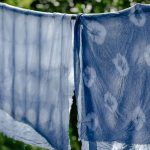When you think about poplin fabric finishes, you might consider how the texture can influence your wardrobe choices. The crisp finish offers a tailored, sophisticated appearance, ideal for more formal settings, while the soft finish invites a more casual, laid-back vibe. But what if you're curious about the unique options like sateen or textured blends? Understanding these nuances can significantly impact your style and comfort. Let's explore how the various finishes can serve different purposes and enhance your fabric selection.
Table of Contents
Key Takeaways
- Crisp poplin offers a polished, structured look, ideal for both casual and formal settings, with excellent breathability and wrinkle resistance.
- Soft poplin provides a relaxed feel, perfect for everyday wear, draping beautifully while remaining lightweight and breathable.
- Sateen finish poplin features a luxurious sheen, making it suitable for dressy occasions and enhancing silhouettes with its gentle texture.
- Textured poplin options, like slub and linen blend, add unique visual appeal and breathability, catering to various style preferences.
Overview of Poplin Fabric
Poplin fabric is a versatile textile known for its smooth finish and lightweight feel, making it a popular choice for clothing and home decor. You'll often find poplin in shirts, dresses, and even bed linens. Its unique construction features a blend of cotton and synthetic fibers, giving it durability while retaining softness.
When you wear poplin, you appreciate its breathability, especially in warm weather. The fabric drapes beautifully, allowing for a flattering fit without being clingy. You can also find poplin in vibrant colors and patterns, making it an excellent option for any style preference.
In addition to clothing, poplin's easy care and resistance to wrinkles make it a smart choice for home textiles. You'll enjoy how it holds its shape, whether in curtains, tablecloths, or cushions.
As you explore poplin, consider its various applications and how it can elevate your wardrobe or home. The fabric's adaptability means it suits both casual and formal occasions, giving you versatility in your choices. Understanding poplin's qualities helps you make informed decisions about incorporating it into your lifestyle.
Crisp Poplin Finish
A crisp poplin finish enhances the fabric's inherent smoothness, giving garments a polished and refined look that's perfect for both casual and formal settings. This finish is characterized by a lighter weight and a slightly stiffer feel, which helps maintain the structure of your clothing. When you wear crisp poplin, you'll notice how it holds its shape beautifully, making it a fantastic choice for dress shirts, blouses, and tailored pieces.
One of the key benefits of this finish is its wrinkle-resistant nature. You won't have to worry much about creasing, allowing you to look sharp throughout the day. Additionally, the crisp texture of poplin provides excellent breathability, making it comfortable even in warmer weather.
Crisp poplin fabrics are often treated with special finishes that enhance their durability and longevity. When you choose garments made from this finish, you're investing in pieces that can withstand regular wear while still looking fresh and vibrant.
Whether you're heading to the office or out for a dinner date, a crisp poplin shirt or dress can elevate your style effortlessly. So, embrace the versatility of crisp poplin in your wardrobe!
Soft Poplin Finish
While crisp finishes offer structure, a soft poplin finish provides a relaxed and cozy feel that's perfect for casual wear.
When you choose soft poplin, you'll appreciate its lightweight nature and smooth texture, making it ideal for comfortable everyday outfits. This finish tends to drape beautifully, allowing your clothing to move with you, which is especially great for active lifestyles.
Soft poplin is often made from a blend of cotton and synthetic fibers, giving it that extra softness while maintaining durability. You'll find that it's less prone to wrinkling, which means you can toss it in your bag without worrying about looking disheveled.
Whether you're dressing up for a brunch or keeping it casual for a day out, soft poplin shirts and dresses offer versatility and style.
Additionally, soft poplin is breathable, making it a fantastic choice for warmer weather. You can enjoy its comfort without feeling weighed down or overheated.
Plus, it comes in a variety of colors and patterns, allowing you to express your personal style effortlessly. So, when you want that laid-back look without sacrificing elegance, soft poplin is your go-to fabric.
Sateen Finish
Sateen finish offers a luxurious sheen and smooth texture that instantly elevates any garment, making it perfect for dressier occasions. When you wear sateen poplin, you're not just adding elegance to your outfit; you're also enjoying the comfort that comes with its soft finish. This fabric drapes beautifully, enhancing your silhouette while feeling gentle against your skin.
Here's a quick comparison of the key features of sateen finish:
| Feature | Sateen Finish | Other Finishes |
|---|---|---|
| Texture | Smooth and soft | Varies (crisp, etc.) |
| Sheen | Luxurious shine | Matte or less sheen |
| Drape | Flows easily | Stiffer feel |
| Best For | Dressy occasions | Casual wear |
With sateen, you'll find it ideal for blouses, dresses, and even bedding. It's versatile enough to transition from day to night effortlessly. Just remember to care for it properly to maintain its stunning appearance; gentle washing and a cool iron will keep it looking fresh. Embrace the elegance of sateen finish and elevate your wardrobe today!
Textured Poplin Options
When you explore textured poplin options, you'll discover a variety of types that each offer unique visual appeal.
These fabrics can elevate your fashion choices, providing versatility for different styles and occasions.
Plus, knowing how to care for them ensures they maintain their beauty over time.
Types of Textured Poplin
Textured poplin comes in various options, each offering unique characteristics that enhance both appearance and functionality. When choosing textured poplin, you'll notice a few popular types that stand out for their distinct looks and feels.
Here are three options you might consider:
- Slub Poplin: This fabric features irregularities in the weave, creating a subtle texture that adds depth. It's perfect for casual wear and gives a relaxed vibe to any outfit.
- Linen Blend Poplin: Combining poplin with linen results in a breathable, lightweight fabric. This blend offers a soft touch and a natural look, making it ideal for warm weather clothing.
- Satin-Finish Poplin: With a sleek, shiny surface, satin-finish poplin elevates any garment's elegance. It's often used for dressier items, providing a luxurious feel without sacrificing the crispness of traditional poplin.
Each type of textured poplin has its own charm, so consider your needs and preferences when making a choice.
Whether you're after casual comfort or refined elegance, there's a textured poplin option that's just right for you.
Applications in Fashion
Many fashion designers embrace textured poplin for its versatility, using it in everything from casual shirts to elegant dresses. You'll find that the fabric's unique texture adds depth and interest to your wardrobe, making it a popular choice for both everyday wear and special occasions.
When you choose textured poplin, you're opting for a material that drapes beautifully, enhancing the silhouette of garments. It's perfect for structured pieces like tailored blouses and fitted skirts, where you want a polished look. Conversely, its softer variants lend themselves well to flowing dresses and relaxed-fit tunics, striking a balance between comfort and style.
Textured poplin also works wonders in layering. You can effortlessly pair it with lightweight cardigans or jackets, creating an ensemble that's both chic and practical. Don't forget about accessories—textured poplin can be used in scarves and bags, adding an extra touch of sophistication to your outfit.
Ultimately, textured poplin is a dynamic fabric choice that can elevate any piece in your wardrobe, allowing you to express your personal style while enjoying the comfort and durability it offers.
Care and Maintenance Tips
Caring for your textured poplin garments ensures they remain vibrant and last for years, so follow these essential maintenance tips. These simple steps will help you keep your clothing looking fresh and new.
- Washing: Always check the care label before washing. Most textured poplin can be machine washed in cold water with a gentle cycle. Avoid using bleach, as it can damage the fabric's texture and color.
- Drying: Air dry your garments whenever possible. If you need to use a dryer, set it on low heat to prevent shrinking and maintain the texture. Remove the garments while slightly damp to minimize wrinkles.
- Ironing: When ironing, use a low to medium heat setting. If the fabric is too wrinkled, lightly mist it with water before ironing. Avoid direct contact with the iron on textured areas, as this can flatten the fabric.
Care and Maintenance Tips
Taking care of your poplin fabric is essential for keeping it looking great.
You'll want to know the best washing techniques, ironing practices, and storage tips to maintain its quality.
Let's explore these important care and maintenance tips together.
Washing Techniques Explained
Understanding the right washing techniques can help you maintain the quality and longevity of your poplin fabric. By following these simple tips, you'll keep your poplin looking fresh and vibrant.
- Choose the Right Water Temperature: Always wash your poplin in cold or lukewarm water. Hot water can weaken the fibers and cause colors to fade, so stick to cooler temperatures for best results.
- Use a Gentle Detergent: Opt for a mild detergent free from harsh chemicals. This helps preserve the fabric's feel and color without causing unnecessary wear.
- Avoid Overloading the Washer: When washing poplin, don't cram too many items into the machine. Overloading can lead to uneven cleaning and wear on the fabric. Give your garments enough space to move freely.
Ironing Best Practices
To keep your poplin fabric looking sharp, it's essential to iron it correctly and at the right temperature. Start by checking the care label for specific instructions. Generally, a medium heat setting works best for poplin.
Before you begin, ensure the fabric is slightly damp. If it's dry, mist it with water to make the process easier. Iron in straight strokes, applying even pressure to avoid any creases.
Here's a quick guide to help you get the best results:
| Ironing Tips | Why It Matters |
|---|---|
| Use a pressing cloth | Protects fabric from shine |
| Iron on the reverse | Maintains fabric integrity |
| Keep the iron moving | Prevents scorching and burns |
Following these practices will not only keep your poplin looking crisp but also extend its life. Remember, a well-pressed fabric can elevate your entire outfit, making you feel more confident and polished. So grab your iron and give your poplin the care it deserves!
Storing Properly Tips
After you've ironed your poplin fabric, proper storage is key to maintaining its crisp appearance and preventing wrinkles. Here are some effective tips to ensure your poplin stays in top shape:
- Hang It Up: Use sturdy hangers to hang your poplin garments. This helps avoid creases and keeps the fabric's structure intact. Make sure to space them out to allow air circulation.
- Avoid Folding: If you need to fold your poplin, do so carefully. Use acid-free tissue paper between folds to minimize pressure and prevent unwanted lines. However, hanging is the best option for long-term storage.
- Choose the Right Environment: Store your poplin in a cool, dry place away from direct sunlight. This prevents fading and damage. Consider using breathable garment bags for extra protection against dust.
Choosing the Right Finish
Choosing the right finish for poplin fabric can significantly impact its look, feel, and durability. When you're selecting a finish, consider how you plan to use the fabric. If you need a crisp, structured appearance for shirts or formal wear, a stiffer finish will serve you well. This kind of finish not only holds its shape but also gives a polished look that's ideal for professional settings.
On the other hand, if you want a softer, more relaxed feel for casual garments or bedding, opt for a softer finish. This will provide comfort against the skin while maintaining the breathable qualities poplin is known for.
Don't forget to think about care requirements, too. Some finishes may require special washing or ironing methods to maintain their appearance.
Lastly, consider the fabric's weight. Heavier finishes can add durability, making them perfect for items that see frequent use, while lighter finishes might be better for seasonal clothing.
Ultimately, your choice should align with your intended use, desired aesthetic, and maintenance preferences. By considering these factors, you'll confidently choose the finish that best suits your needs.
Frequently Asked Questions
What Types of Garments Are Best Suited for Poplin Fabric?
You'll find poplin fabric ideal for shirts, blouses, and dresses due to its lightweight, breathable nature. It's also great for tailored pants and skirts, giving you a polished look while maintaining comfort in various settings.
Is Poplin Fabric Suitable for All Seasons?
Yes, poplin fabric's lightweight nature makes it suitable for all seasons. In summer, it keeps you cool, while in winter, layering with it provides warmth without bulk. You'll appreciate its versatility throughout the year.
Can Poplin Be Dyed Easily?
Yes, you can dye poplin fabric easily. Its smooth surface absorbs dyes well, allowing for vibrant colors. Just make sure to follow the dye manufacturer's instructions for the best results and to achieve the desired shade.
How Does Poplin Compare to Other Fabrics Like Cotton or Linen?
When you compare poplin to cotton and linen, you'll find poplin's smoother texture and durability stand out. It's lightweight yet strong, making it ideal for clothing, unlike linen's tendency to wrinkle or cotton's heavier feel.
What Are the Environmental Impacts of Producing Poplin Fabric?
Producing poplin fabric can have significant environmental impacts. It often requires substantial water, pesticides, and energy. By choosing sustainable practices and organic fibers, you can help reduce these negative effects and support eco-friendly production methods.
- How Does Ring Spun Cotton Affect Garment Fit and Shape Retention? - August 13, 2024
- What Are the Challenges in Producing Ring Spun Cotton? - August 13, 2024
- Is Ring Spun Cotton Suitable for Plus-Size Clothing? - August 13, 2024







